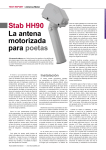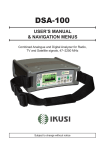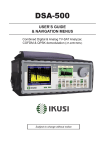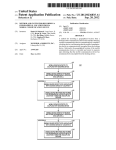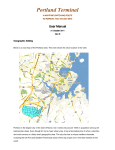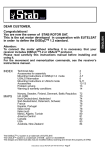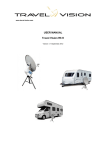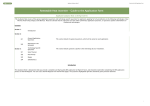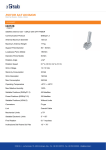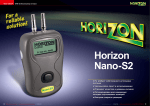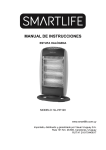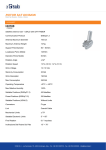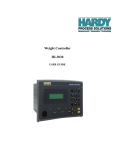Download Stab HH90 Motorized antenna for poets - TELE
Transcript
TEST REPORT Antenna Motor Stab HH90 Motorized antenna for poets ing all the necessary hardware accessories: screws, nuts, clamps, bolts, F-type connectors with protective covers and even a simple spanner for assembling everything. Last but not least, you will find a very helpful user manual inside the package. It is full of pictures and detailed explanations. Almost all the parts are made of metal; only a portion Have you ever thought about looking for channels on satellites other of the motor‘s cover is plastic. Despite that, than the only one that you can receive with your fixed dish? Were you the entire assembly is very light (2.6 kg) and deterred from doing that by the complexity of the motor setup and its compact. It is durable in appearance and the cost? Well, we have good news for you! The new Stab motor - HH90 is workmanship leaves nothing to be desired. for everybody. Installation The motor and its accessories are packed downwards - not upwards. Moreover, the The motor can be controlled by USALS or in a small carton. If you never worked with shaft is not permanently connected to the DiSEqC 1.2 compatible receivers. We used hardware like this before, it will probably motor. The shaft should be first attached a USALS system first. surprise you how easy and simple all this is. to the dish and then to the motor‘s pivot. installation, you should find the geographical The hardware consists of three main compo- This is done with only one screw. The part coordinates of the location where the antenna nents: a motor with built-in control circuitry, to which you fasten the dish is 14.5cm long. is to be installed. You can read them either a bracket used to fasten the motor to the Thus only unusual dishes having two U-bolts from a map (an accuracy of 0.1° is more pole and a shaft. The HH90, in contrast with far apart for mounting will pose a problem. than sufficient) or find them on the Internet. two other members of the Stab HH family Except for the three main components men- Instead of „googling for it“, you can try the (HH100 and HH120), has its shaft directed tioned above, there is a plastic bag contain- service provided by Stab on their webpage, Before starting the www.usals.info. After entering the type of motor (HH90), your country, city and e-mail address, you will get an automatic response providing the necessary data. We were really surprised to discover that the system also worked for very small village locations - and not only for larger towns. In addition to the Longitude and Latitude values, you will also need to know the Dish Elevation expressed as an angle in degrees. If you don‘t get it from the Stab automatic service, you can find it on the paper maps attached to the user manual. Once all three parameters are known, you can proceed with the actual installation. The first very important step is to make sure that the pole on which you want to mount the motorized dish is perfectly vertical. Use a spirit level or plumb line to check it. Then, mount the motor in the bracket at an angle corresponding to your latitude. The scales engraved on the motor‘s case are used for this purpose. You simply set the angle equal to your latitude. The next step is to fix the bracket and the attached motor to the pole with the included U-shaped bolts and brackTELE-satellite International — www.TELE-satellite.com Antenna Motor ets. Well done! You have completed the first stage of installation. Now take the shaft and TEST REPORT Hints for Beginners attach it to the dish. Do it carefully to avoid If you are quite new in this business and channels. Another reason for not receiving any skew between the shaft and dish axis of you have just finished the installation, first channels (or receiving only a few) may be the symmetry. Adjust the angle between the dish find out which satellites are transmitting in outdated transponder satellite data in the and the shaft. Set the elevation reading on your direction. Otherwise you may be dis- receiver’s software. If your receiver is Sat- your dish to the angle equal to the Dish Eleva- appointed that your receiver cannot find any coDX compatible – no problem, updating the tion parameter. If your dish lacks the elevation channels on this or that bird. A satellite may data will be a piece of cake. Otherwise, you scale, you will have to adjust its elevation by be perfectly visible from your location, you may be forced to do it manually. After that a trial and error once everything is mounted on may have the largest possible dish mounted repeated channel search should provide you the pole. So, if you lack experience in aligning but your receiver may not be able to find a a number of new channels. satellite dishes, you might be better off with a single channel on a satellite! Probably, your dish that has an elevation scale. first thought will be that you did something There is yet another trick that you can do to wrong with the installation. Calm down and improve your reception. When your installa- During our tests, we used a 90cm offset approach it methodically. A good start is to tion is complete and the first satellite channel dish equipped with an Invacom quad LNB for use SatcoDX World of Satellites software search is over, try experimenting a little. In the Ku-Band. The LNB had a noise figure of attached to every issue of TELE-satellite the DiSEqC/USALS settings of your receiver, 0.4dB. Of course, you can use a smaller dish International. Using the Dish Track tool you change your longitude setting by, say, 0.3° and a single, twin, quatro or other type of can generate a list of satellites that can be East. LNB. The HH90 is suitable for dishes up to received in your location. Remove from the meter if the signal quality has increased or 95cm. Observe on your receiver’s signal The larger the dish and the smaller list the satellites that require a significantly decreased. Then check the reception when the noise figure of LNB, the better the signal larger dish than you have (e.g. 120 vs. 90 your longitude setting is changed by 0.3° quality and weather margin that can be cm). Next, make sure that the remaining West from your normal value. achieved. satellites transmit in the band your LNB with a number of settings to find the best Experiment can receive. In practice, this will be the Ku- quality of signal. The next step is to attach the shaft and the band since the C -band generally requires found at your true longitude but somewhat If the maximum is not dish to the pivot of the motor. This is done with big dishes and HH90 motor is not the best east or west, it means that the dish is not just one screw and one nut. Then you slightly solution for this band. So remove the satel- perfectly aligned in azimuth. You may either loosen the nuts on the U-bolts around the lites broadcasting only in C-band from your mechanically correct its alignment (which is pole and rotate the entire assembly (motor, list. Check the SatcoDX chart to make sure the recommended solution) or cheat your shaft and dish) to point the antenna exactly that there are “normal” TV or radio channels receiver by leaving the false data which gives to the south. Now it‘s time to connect the on the satellites that are still on your list. If the best result in the receiver’s USALS instal- cables. Instead of going directly to the LNB, there are only “feeds” listed in the chart, your lation menu. A difference of 1 degree or less the cable from your receiver must go to the receiver will probably not recognize them as can be corrected in this way. nector on the motor and the LNB itself. When indicator to find the maximum signal. Once it East to Hispasat 1C, 1D at 30° West, over the cabling work is done, you should bring up is found, the installation is complete. Tighten 20 satellites altogether. These carry more the installation menu in your USALS compat- the fixing screws and nuts. Settings for all than 2700 TV channels including about 720 ible receiver. Here you enter your geographi- other satellites from horizon to horizon are unscrambled ones. cal coordinates and select a satellite that is determined automatically by the Stab motor aligned as close as possible to south. That and USALS compatible receiver. No further means that if your longitude is close to 19° adjustments are required. „REC“ connector on the motor. Another short cable has to be added between the „LNB“ con- East you should select Astra 1, if it is closer to The manufacturer specifies that the dish rotates at 2.4°/sec. when powered from 18V and 1.5°/sec. for 13V. When moving between Everyday Use onds or 53 seconds depending on the polari- the antenna will move slightly. The final step When the motor is installed, the next obvi- zation of the channel (and thus the voltage is to fine-tune the azimuth alignment (rotate ous action is to move the dish from one sat- the receiver generated). This gives 2.0°/sec. the entire assembly after loosening the U- ellite to another and search for channels. and 1.4°/sec. which are slightly slower than bolts on the pole) and the elevation angle of In Western Poland, we were able to receive the figures specified, probably because the the dish. satellites ranging from Panamsat 12 at 45° manufacturer‘s measurements were taken 13° East, you should use Hotbird instead and so on. The motor will run for a short time and Use your receiver‘s signal quality 45° East and 30° West we found it took 38 sec- www.TELE-satellite.com — TELE-satellite International factor, it is relatively easy to determine if the house, you will not be annoyed by its noise dish is correctly aligned or not. With a 90cm while enjoying warm summer evenings in the dish, even a 0.2° difference in azimuth can be garden. Most likely, you won‘t even notice noticed on a receiver‘s signal quality reading. that the Stab HH90 is operating - that‘s how A large dish is heavy and presents a greater quiet it is. surface area to the wind. So, if a motor performs well with a large dish, it will undoubtedly perform well with a smaller dish. After confirming that the motor worked well with USALS compatible receivers, we did a test with a DiSEqC 1.2 compatible without a dish. Moreover, we cannot rule out We must say that the Stab HH90 worked receiver. As expected, the installation took flawlessly no matter how many times and in much longer. The Stab HH90 also worked which direction (east or west) it was rotated. with that receiver without any problems. It always returned to the exact position The motor has 28 preprogrammed satellite required for a given satellite. We could not positions (suitable for reception in Europe) observe any differences in signal level and and there is still room for an additional 21. quality after turning the dish to many satel- Some DiSEqC 1.2 receivers can use this data lites and then returning to the initial one. The to speed up the installation process. In such noise generated by the motor is very low. a case, the DiSEqC 1.2 installation is as easy If you install the motor on the roof of your and fast as the USALS installation. the possibility that our test receiver generated somewhat lower voltages than 18v and 13v respectively. When you switch between channels broadcast from neighboring satellite positions (3° or so), the delay is about 2 seconds - which is very acceptable. As already mentioned, we used almost the maximum allowable dish size (90cm) to test the motor. That‘s because, the larger the dish, the narrower its beam. Thanks to this TELE-satellite International — www.TELE-satellite.com + Expert conclusion Stab HH90 is really simple to install. Its user manual is perfect. Finding the necessary geographical data for your location is very easy if you use Stab’s web page. It is both USALS and DiSEqC 1.2 compatible. - None Peter Miller TELE-satellite Test Center Poland Antenna Motor Receiving Hispasat 30 West TEST REPORT Receiving Turksat 1C 42 East TECHNICAL DATA Manufacturer STAB S.r.l., Via Seminiato, 79, 44031 Ambrogio (FE) Italy, www.stab-italia.com, E-mail [email protected] Phone +39-0532-830739 Fax +39-0532-830609 Model HH90 Description DiSEqC 1.2 and USALS Compatible Dish Motor Communication protocol DiSEqC 1.2® Level Maximum dish diameter 95 cm Maximum dish weight 10 Kg Rotor weight 2.6 Kg Diameter of support pole ø (35 to 68) mm Dish support length 145 mm Dish support diameter ø 42 mm Rotation angle ±65° Rotation speed 2.4°/s for 18V, 1.5°/s for 13V (in our tests with 90 cm dish: 2°/s and 1.4°/s) Operating power supply 13/18 Vdc Consumption in stand-by mode 40 mA Consumption in operating mode 180 mA Starting movement consumption (max) 350 mA Operating temperature -40°C +80°C Maximum relative humidity 100% Programmable positions (DiSEqC 1.2®) 49 satellites Preset positions (DiSEqC 1.2®) 28 satellites Programmable positions (USALS®) no limits Connectors F type Connection Coaxial cable Mechanical limits ±72° Programmable electrical limits from 5° to 65° Fine rotation by impulses of 0.1° Inclination of the rotor on the pole from 10° to 70° www.TELE-satellite.com — TELE-satellite International






